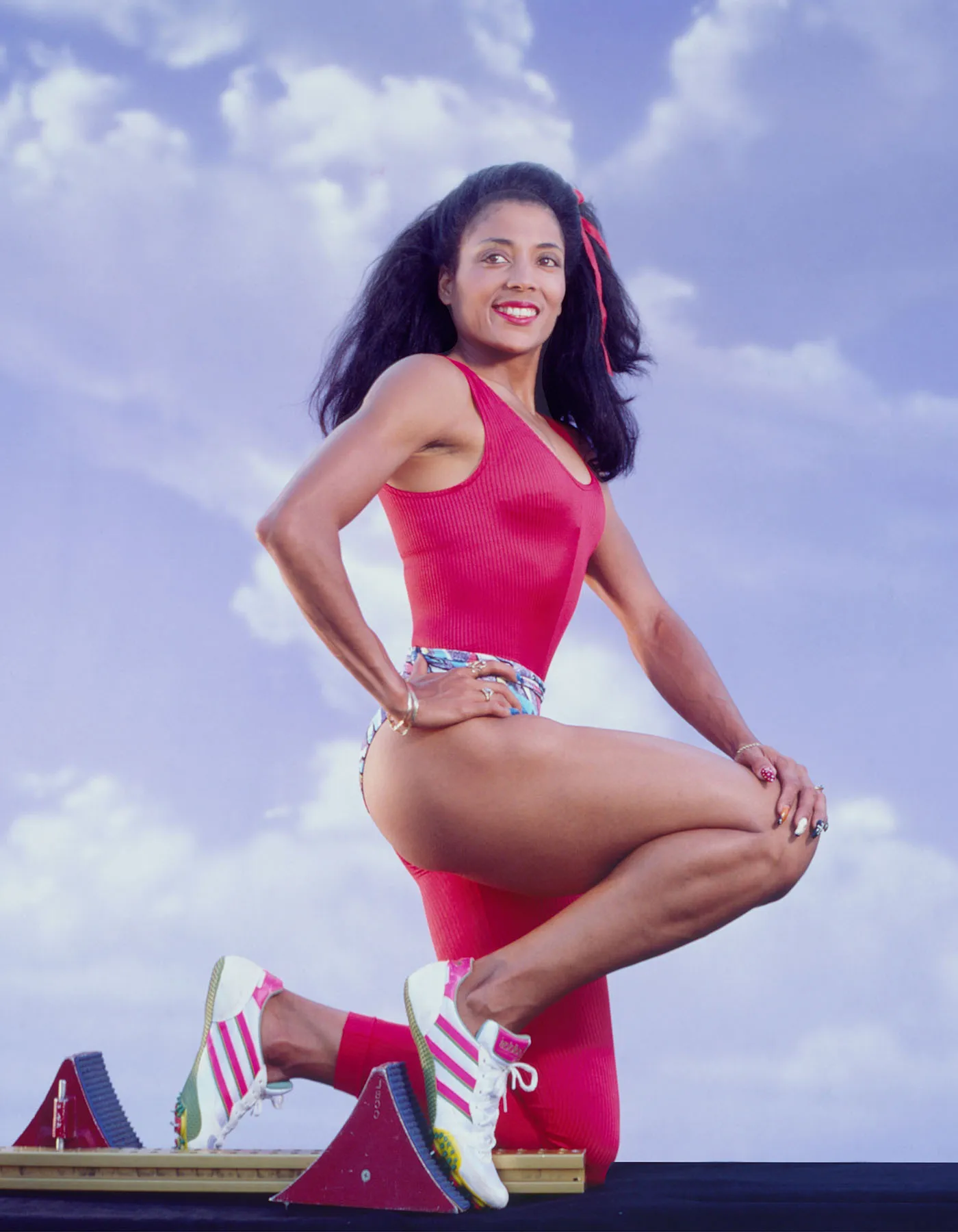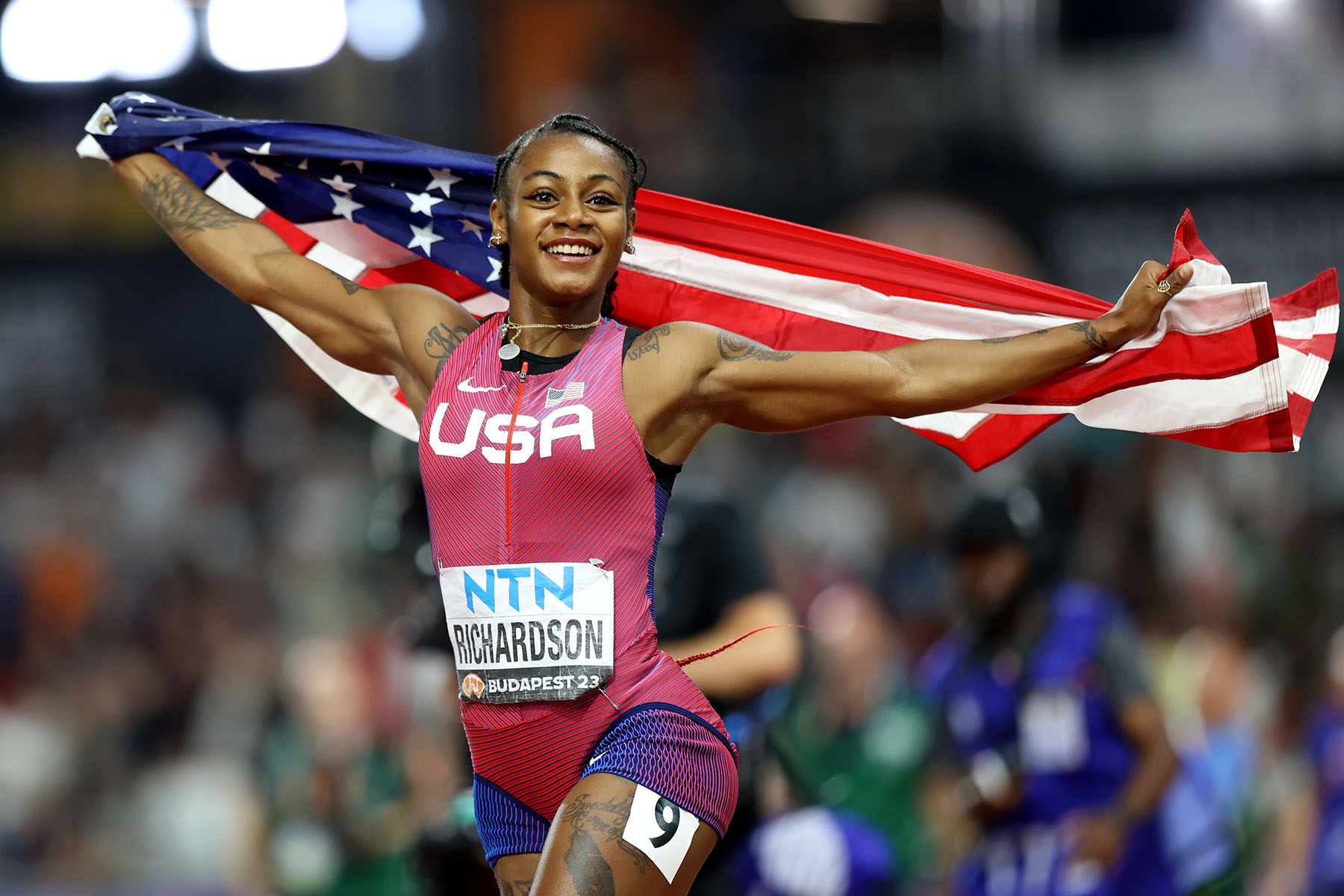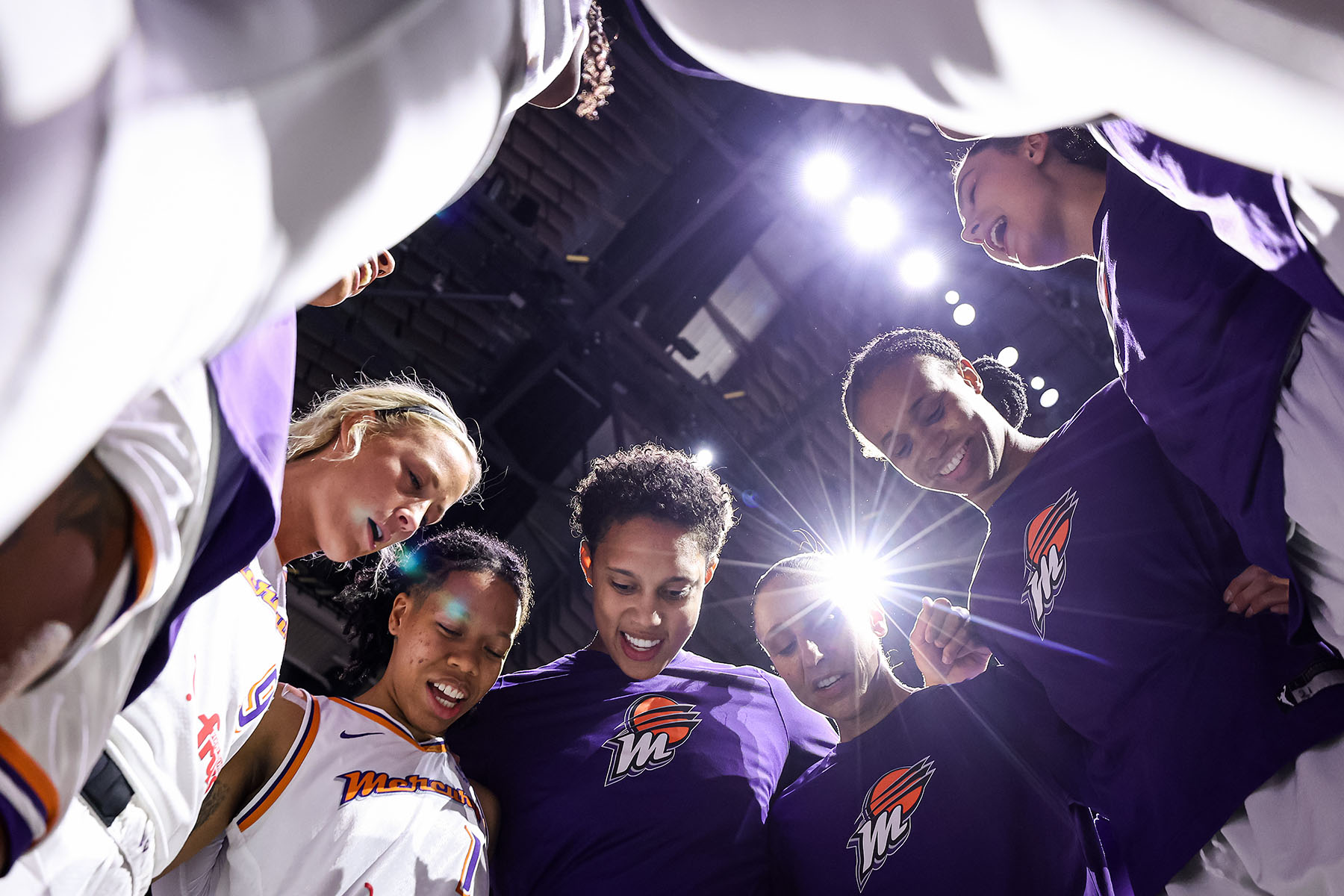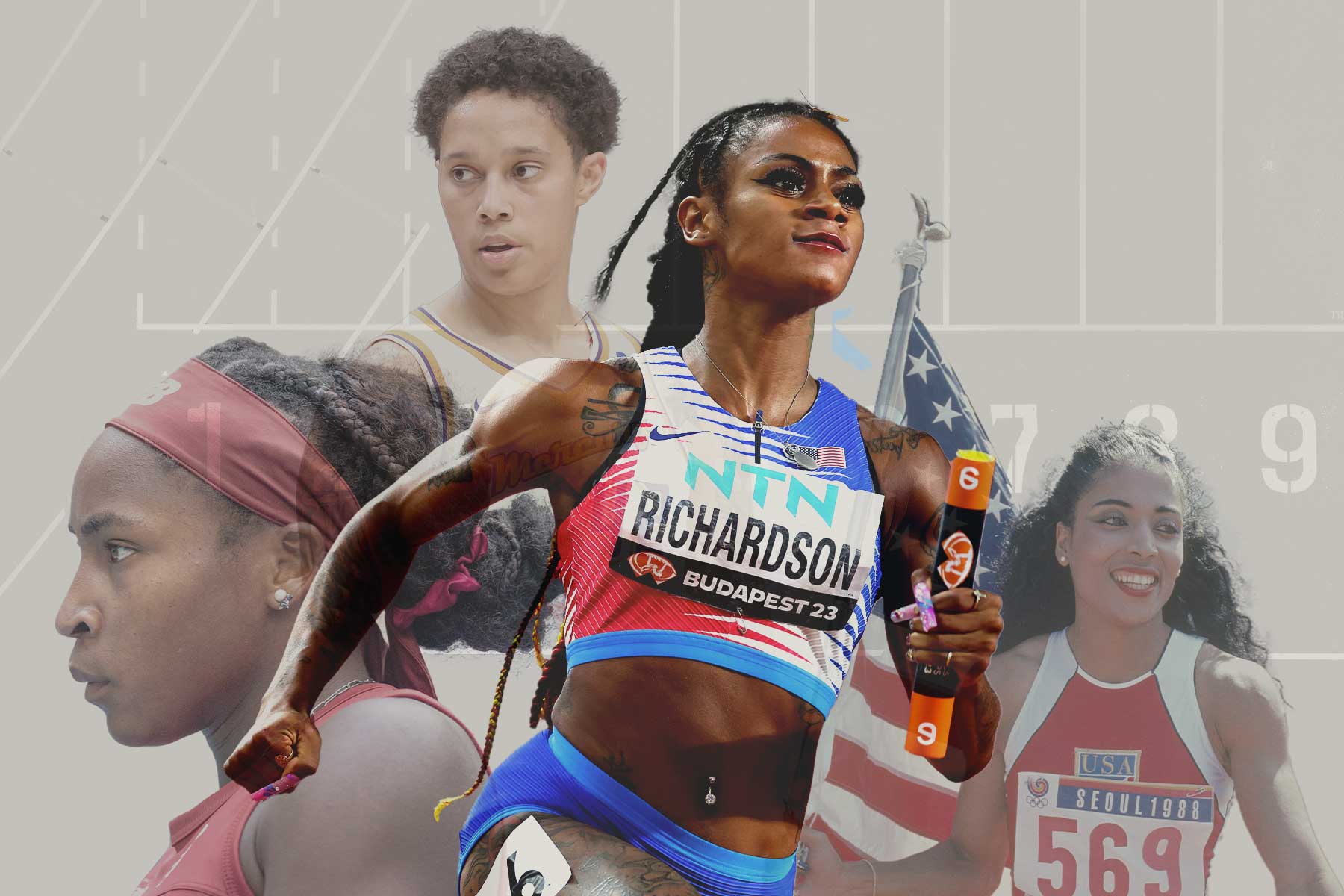Your trusted source for contextualizing America’s core issues. Sign up for our daily newsletter. Want to support this work? Donate today.
During her last race of the track and field season, sprinter Sha’Carri Richardson finished in fourth place, but that outcome didn’t demoralize her.
Instead, the 23-year-old beamed after the Prefontaine Classic in Eugene, Oregon, on Saturday — telling reporters that there’s no limit to what she can achieve in her career.
“I feel like for a while I saw this sport more as a job than the love I knew I had for it,” she said, noting that she has been working toward joy and inner peace. “I’m just whole all over again.”
With her hair in a wavy two-toned Afro instead of the brightly colored wigs and braids she tends to wear while competing, Richardson looked whole, too. Her hairstyle made headlines, as Richardson has since she gained global recognition as an Olympic trials contender in 2021.
Richardson is just one of many Black women athletes, including Serena and Venus Williams, Coco Gauff, Angel Reese, Brittney Griner and the late Florence “Flo-Jo” Griffith Joyner, who have attracted intense scrutiny around — and been attacked for — their behavior during competition, interactions with reporters, flair for fashion, self-confidence or rule breaking in ways that other athletes have not, experts told The 19th.
“It almost seems like we have to be superheroes,” Richardson told Teen Vogue last year. “It’s just irritating because you take away the abilities, you take away the speed, you take away the talent … and we’re still human.”
With a bold personality and sense of style, Richardson particularly lives at the intersection of multiple marginalized identities. In addition to being a Black woman, Richardson has said that she is bisexual and a survivor of initmate partner violence, a suicide attempt and parental abandonment, having grown up in largely impoverished South Dallas with her grandmother and aunt as caregivers.
Despite the trauma she’s endured, it took her becoming the fastest woman in the world after winning the women’s 100 meter at the track and field world championships in Budapest in August to renew a skeptical public’s faith in her. And, after that feat, there’s no guarantee that she won’t continue to be subjected to the respectability politics that have long targeted Black women athletes, a pattern scholars say needs to change.
“It’s all kind of a discourse of respectability politics,” said Sabrina Razack, an assistant professor in the University of Toronto’s Kinesiology and Physical Education department and the Canada project lead for the Centre for Sport and Human Rights. “What’s respectable for women to do? What’s respectable for how she behaves, how she talks, how she presents herself, how she treats her body? If you’re aligning with what is a respectable woman, it’s one who is obedient, one who behaves, one who answers questions when asked, one who doesn’t show anger. But this is also a classic case of misogynoir that is specific toward Black women in the media.”

Whether on or off the field, Razack said, the bar for how women conduct themselves is much higher than it is for men. When race and class are also involved, the expectations become more rigid.
After Richardson first garnered widespread public attention two years ago, her colorful hair and long ornate nails elicited favorable comparisons to Flo-Jo. But then she tested positive for cannabis following her biological mother’s death. Her marijuana use led the U.S. Anti-Doping Agency (USADA) to suspend her for a month, keeping her from the Tokyo Olympics — and public sentiment toward her soured.
“Some people are just fairweather fans; they’ll switch with the tides,” said Christina Greer, an associate professor of political science at Fordham University who has written about sports and respectability politics. “She struggled after her mother died. We’re expecting someone to go do their job at the highest levels after their mother died. Grief doesn’t doesn’t go away in 24 hours, and there was some trauma in the family. … I think there’s a level of grace and understanding that people just don’t have for public figures, and that goes for all public figures, especially athletes, but especially for Black athletes, and most especially for Black women.”
Richardson’s supporters have argued that both the public and the USADA were too hard on the young runner, given that athletes such as Michael Phelps have used marijuana and many others have been ensnared in doping scandals, which Richardson herself pointed out after she was sanctioned. Specifically, Richardson questioned why the Olympics allowed then-15-year-old figure skater Kamila Valieva to compete last year after the Russian youth tested positive for a banned heart medication. While the USADA suspended Richardson, a different organization, the Court of Arbitration for Sport, allowed Valieva to compete, noting that she was just a minor and therefore a “protected person” in the context of the World Anti-Doping Code. Phelps, on the other hand, was suspended for three months in 2009 after a photograph of him smoking cannabis surfaced. The suspension did not prevent him from competing because he consumed marijuana after the Olympics, not before it.
The differences in these cases have done little to change the perception that the USADA treated Richardson unfairly.
“She was definitely treated more harshly because marijuana is not a performance-enhancing drug,” said Mia Moody-Ramirez, chair and professor of journalism, public relations and new media at Baylor University’s College of Arts & Sciences and whose research includes image repair theory. “Many people would say, if anything, it would hamper her performance. And there are other athletes who have actually used performance-enhancing drugs, but they were still allowed to compete.”
-
More from The 19th:
A 2018 article in the Clinical Journal of Sports Medicine found that “there is no direct evidence of performance-enhancing effects in athletes” who use cannabis. But the USADA prohibits cannabis consumption because athletes could presumably hurt themselves or others due to the sluggishness induced by the drug. While legal in many states, marijuana is still an illicit substance nationally, casting doubt on whether athletes who use it can serve as role models, according to the agency. Also of concern is that many countries that compete in the Olympics ban the drug, which could enhance performance by curbing anxiety, a plus for nervous athletes. Since Richardson did not use cannabis before a competition, however, none of these concerns apply to her consumption of the substance.
After her suspension, advocates for marijuana legalization, medical professionals and politicians were among the individuals questioning the USADA rules. But the anger directed at Richardson didn’t dissipate, with some of her detractors taking aim at her appearance, particularly her artificial eyelashes, colorful wigs, numerous tattoos and piercings, about which they made classist comments.
“In response to her behavior, I heard every word in the lexicon — from ‘hood-rat,’ ‘ghetto,’ ‘low-life,’ etc.,” Ciera Graham, a higher education professional and writer, noted in a Medium post shortly after Richardson’s positive drug test in 2021. “Of course, society has never granted Black women the grace of separating or distinguishing their behavior from their character — weed is bad and thus all Black people who use it must be bad too.”
Brittney Griner, the WNBA star convicted of drug smuggling in Russia after cannabis oil was found in her luggage, was regarded similarly. Although President Joe Biden secured her release from the country in December, some Americans wanted her to remain in a Russian prison because they believed her “crime” warranted it, experts told Business Insider last year. But Griner had a doctor’s prescription to use the cannabis oil and said that she didn’t know that it had been packed in her luggage. Scholars also told the publication that the fact that Griner is Black, queer and gender-nonconforming reduced public sympathy for her, an argument that could also be applied to Richardson minus the gender-nonconforming component.

“She is a unique person, and she takes pride in her style, in the way she dresses, in her nails, and she’s just going to keep doing what she does,” Moody-Ramirez said. “But I think she probably will continue to be criticized because people expect women to behave a certain way, and because she doesn’t fit that mold, she’s going to be criticized.”
That said, attacking Black women athletes for how they present themselves dates back decades. The late Flo-Jo may be universally celebrated now, but her elaborate manicures caused the news media to shame her after she became famous in the 1980s.
“Writers highlighted Flo-Jo’s fingernails as both a source of intrigue and revulsion, subtly emphasizing racial differences. Because she preferred long, colorful nails, the runner was depicted as abnormal, deviant, and different,” wrote Lindsay Pieper, an associate professor of sport management and chair of the Sport Management Department at the University of Lynchburg, in a 2015 paper.
Greer said that Flo-Jo and her sister-in-law and fellow track-and-field athlete Jackie Joyner-Kersee faced questions about their appearance. “There were always conversations about how they were unacceptable,” she said. “Why are they wearing gold chains? Why are they wearing makeup? Why is their hair done in a particular way? Why did they have these nails on? It’s like, ‘Because they’re going to win, and they know they’re going to be on the front page of Sports Illustrated, so they want to look good.’”
In 1988, the same year the Chicago Tribune pointed out Flo-Jo’s “4-inch, curved, tiger-striped fingernails,” figure skater Debi Thomas won a bronze medal, becoming the first Black woman to receive a medal in the Winter Games. Thomas has since revealed that she underwent ethnic rhinoplasty well before this milestone after she was advised that a nose job would likely result in better scores from judges. A premed student at Stanford University while competing for Olympic glory, Thomas was highly respectable, but that didn’t prevent the International Skating Union from banning women skaters from wearing costumes without skirts after she competed in a unitard during the 1988 Winter Games. In 2009, Thomas said that she thought the unitard was modest and that she was not the first skater to wear one. On her Black body, the garment suddenly became objectionable.
In 2018, Serena Williams found herself at the center of a similar controversy after wearing a catsuit at the French Open that she said would help her circulation, as she’d suffered a series of blood clots in the year prior, including after the birth of her daughter Alexis. Just as Thomas was not the first person to wear a unitard as a professional skater, Williams was not the first person to wear a catsuit in pro tennis. That distinction went to Anna White at Wimbledon in 1985. But excessive attention to their sartorial choices was not new to the Williams sisters, who were even ridiculed as youngsters for wearing their hair in braids with beads, once a common style for Black girls. Venus Williams was penalized after some of her beads fell out during competition.
“They just want these women to win and perform for the United States and then just go sit down,” Moody-Ramirez said. “They don’t want them to have a personality, to dress up or be different.”
How Black women behave as competitors has also been heavily scrutinized. Richardson and Venus Williams have both been questioned for daring to exude confidence. Richardson and tennis star Naomi Osaka have also been called out for snubbing the news media. Osaka was actually fined for doing so. And acting in a way that’s even perceived to be aggressive has led to criticism of Black women athletes. In August, Coco Gauff, who went on to win the U.S. Open this month, sparked debate after she complained about an opponent’s regulation violations. She earned both praise and pushback, often divided along race and gender lines, for approaching the chair umpire with her concerns.

Four months earlier, Louisiana State University women’s basketball star Angel Reese was labeled “unsportsmanlike” and “classless” during the women’s NCAA tournament championship in April for making the same gesture — moving a hand across the face and touching the ring finger — that both the White star of the opposing team, Caitlyn Clark of the Iowa Hawkeyes, and other White athletes had made without backlash. The controversy affected First Lady Jill Biden, who remarked after the LSU Tigers won the championship that she wanted both teams to visit the White House, when losing teams do not traditionally make the trip to the nation’s capital. Biden’s wish to invite both teams was thought to be a slight against Reese, who initially declined to visit Washington as a result.
Razack said that Black women exhibiting the same bravado as other athletes sparks backlash because they are perpetually expected to be “humble” or simply “grateful to be there” to remain in society’s good graces. For having swagger and the guts to say “I’m that girl,” Richardson has been called “arrogant,” widely believed to be a modern-day way to call Black people “uppity.”
More than anything, Greer believes Richardson has been denigrated and maligned because she is a Black woman that the mainstream does not view as representative of the United States, “whether it’s the hair, the makeup, the nails, or where she’s from, and her background or her story,” Greer said. “To her credit, she didn’t just go away. She trained, she got better and she came back to become the fastest woman in the world.”
That Richardson made a comeback after a notorious comeuppance gives Razack hope that the public won’t continue to harshly judge Black women athletes, but she does not expect misogynoir in sports to disappear.
“Each time a moment like this happens, we do move the needle a little bit,” Razack said of Richardson’s recent success. “What we’ve seen after George Floyd is this racial reckoning. The rock has been pushed up the hill, but now we see the rock coming back down a little bit, and we still have to continue pushing it up the hill. I think that we’ll continue to have these instances happen. Yes, there will always be the haters, so we must continue to protect, support and rally around Sha’Carri. I am happy that I see her smiling.”







